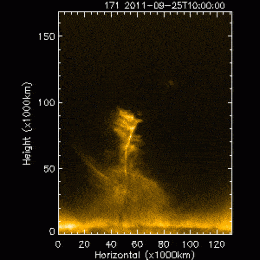
“This is perhaps the first time that such a huge solar tornado is filmed by an imager. Previously much smaller solar tornadoes were found my SOHO satellite. But they were not filmed,” says Dr. Xing Li, of Aberystwyth University.
The tornadoes were observed on 25 September 2011, and astrophysicists estimate they got as hot as 2.000.000 degrees, sucking the root of a dense structure called prominence and spiraling up in the air and traveling about 200 000 kilometres along helical paths for a period of at least three hours.
“This unique and spectacular tornado must play a role in triggering global solar storms.”, added Dr. Huw Morgan, co-discover of the solar tornado.
The extremely hot gases travel at speeds as high as 300,000 km per hour, while typically, tornadoes on Earth have 150 km per hour. The tornadoes occur at the roots of huge coronal mass ejections, and they can cause significant damage to our planet’s space environment, satellites, and even power grids.









